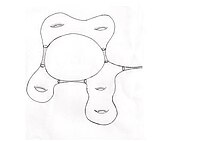Tip (differential geometry)
In the mathematical field of differential geometry , certain "very rapidly narrowing ends" are called peaks .
definition
A peak is one end of a Riemannian manifold , the surrounding area of which is a distorted product
can be parameterized with
- .
Here is a Riemannian manifold of dimension and is the parameter of the second factor in .
The manifold is called the cusp cross section.
Examples
- Peaks of -dimensional hyperbolic manifolds have a -dimensional flat manifold as cross section .
- Peaks of -dimensional complex-hyperbolic manifolds have a manifold as a cross-section, the universal superposition of which is isometric to the -dimensional Heisenberg group .
- Peaks of quaternionic-hyperbolic manifolds have a manifold as cross section, the universal superposition of which is isometric to the quaternionic Heisenberg group .
- In a locally symmetrical space of finite volume and rank , all ends are points; their cross-section can be determined from the Langlands decomposition .
Vertices of hyperbolic manifolds
The tips of a hyperbolic manifold are isometric to a submanifold of shape
- ,
where is a horoball around a point at infinity and a discrete group of parabolic isometries with a fixed point .
So that it is a point in the sense of the above definition, must
- be.
In hyperbolic geometry (and more generally in the theory of locally symmetrical spaces ), an edge point at infinity is often referred to as a point even if there is a non-trivial, discrete group of parabolic isometries with a common fixed point. So you don't ask that is.
For a peak defined in this sense , one can also consider the quotient , which is one end of the manifold . If is, then that end has infinite volume and is not of the shape defined above. One then speaks of a top rank .
From Margulis' lemma it follows that the thin part of an orientable hyperbolic 3-manifold is either a tip of rank or or a tube environment of a closed geodesic . The peaks of rank 1 are homeomorphic to with , the peaks of rank 2 are homeomorphic to for the torus .
literature
Michail Kapovich : Hyperbolic manifolds and discrete groups. Reprint of the 2001 edition. Modern Birkhäuser Classics. Birkhauser Boston, Inc., Boston, MA, 2009. ISBN 978-0-8176-4912-8






































